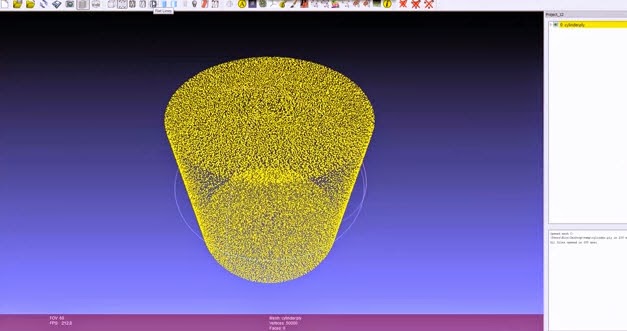
Use the 'Mesh From Point' tool to generate a surface mesh from the imported Points. Step 2: Create Normals and Mesh Step 3: Export to STL Resources Step 1 File Import. Use the Tools > Dimensions > XYZ Text >Import Coordinates tool to place Points in the model at the coordinates defined in the exported *.xyz file.Ħ. Optional: Detach the *.pod file from the modelĥ. Note: Use the ' Density ' and ' Region Filter ' ( Use the 'Clip' tool on the Point Clouds dialog to define region ) options on the Export Point Cloud dialog to define the level of detail / area required.Ĥ. On the 'Export Point Cloud' dialog set the Format to ASCII Files (*.xyz ) and select OK to save.
MESHLAB GENERATE MESH FROM POINT CLOUD HOW TO
This tutorial demonstrates how to use it to align dense point.

Highlight the attached file in the Point Clouds dialog and select File > Export MeshLab is a powerful, open source program that allows users to edit point clouds and meshes.Open the Point Clouds dialog ( File > Point Clouds ) and attach the Point Cloud file ( File > Attach ).This algorithm will add more detail to the mesh.How to generate a surface mesh from a Point Cloud of a Digital Terain Model. This time distribute points by going to Filter > Re-meshing-simplification and reconstruction > Use sub-division algorithm called LS3 loop. Now approximate more normals using the point cloud to add more detail. I import a 1 inch subsampled cloud into MeshLab, compute normals for the point set, and then run Surface Reconstruction with Ball Pivoting. Summary: MeshLab is an opensource, portable, and extensible system for the processing and editing of unconstructed 3D triangular meshes.This tutorial shows. Hi, I use MeshLab to create meshes from point clouds. Turn on the Light found within the tool bar and also turn on Smoothing which is next to the light button. You could also export the mesh and import it into Blender Once in Blender you could assign a subdivide modifier to the mesh and divide as many times as you like. 18 days ago Evan Hemingway modified a comment on discussion Help 19 days ago Evan Hemingway posted a comment on discussion Help. Make the numbers bigger if the point cloud is big. One can provide a point cloud and pass it to the samplepointspoissondisk method. Most of the time you have to deal with overlapping point clouds, gaps, irrelevant points, measuring noise and so on. The method supports two options to provide the initial point cloud: Default via the parameter initfactor: The method first samples uniformly a point cloud from the mesh with initfactor x numberofpoints and uses this for the elimination. Now go to Filters > Point Set > Surface Reconstruction: Poisson, set parameters, 12 for Octree Depth and 7 for Solver Divide, these numbers can be changed depending on the scale of the original point cloud mesh. It is usually not straight forward to generate CAD models from scanned information. When I change the location coordinates to 0, 0, 0, the point cloud moves to the center. This will create an even sampling distribution of the cloud points, and will give a general surface to work with. From here the objects location coordinates will be way off from the scene center. Now create a subset of the point cloud, go to Filters > Sampling > Poisson -Disk sampling, change the Number of Samples to 5000 and check the box for Base Mesh Subsampling. I know that MeshLab has some tools to deal with point clouds, as does Houdini. Turn on layers from the top menu bar View -> Open Layer Dialog. I have to import the point cloud in Maya, generate a mesh from it and.
MESHLAB GENERATE MESH FROM POINT CLOUD SOFTWARE
Kazhdan and is used for example in the mesh processing software MeshLab as.

Change the camera to -1000 so that the sampling program knows that the cloud point data was taken from a large distance, this would give it a better idea where the normals should go. After scanning an object into a point cloud, we want to create a mesh from. Recompute normals using Filter > Point Set -> Compute normals for point sets, change number to 16 for the number of neighbors and also check the box for Flip Normals.


 0 kommentar(er)
0 kommentar(er)
